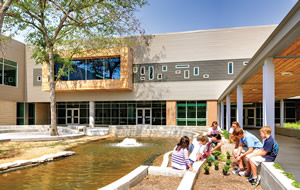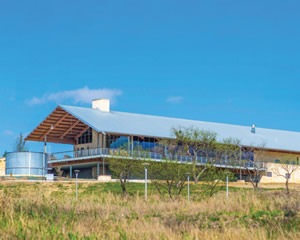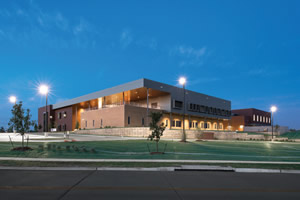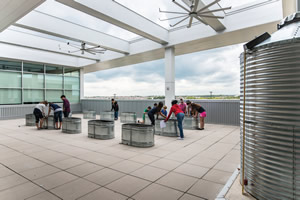Classrooms in the Great Outdoors
- By Michael Fickes
- 05/01/18

PHOTO COURTESY OF STANTEC / © LUIS AYALA
The great outdoors is also a great classroom, which educators forgot about for a number of years. Today, however, the great outdoors is making a comeback.
“People are beginning to realize the importance of outdoor education,” says Terry Hoyle, a principal with Edmonton, Alberta-based Stantec. Hoyle works out of Stantec’s Plano, Texas offices. “Students always need a place to burn off steam and socialize, but we lost the idea of outdoor education for a while. Today, the educational community is becoming interested in outdoor education again. They see outdoor educational opportunities in engineering, math, science—all of the basic subjects.”
And, of course, there are opportunities in the natural world. Recall Henry David Thoreau’s Walden, about the two years he spent living at Walden Pond, near Concord, Mass.
Scholars a bit older than the rest of us note the educational opportunities illustrated by Thoreau’s Journal, a work of more than 2 million words—many of which are devoted to observations of nature encountered during his walks.
A recent national survey by Wakefield Research of 500 elementary school teachers confirmed the value of outdoor activities for students. One hundred percent of the teachers surveyed said that “recess is essential for young students’ mental and physical development.” The International Play Equipment Manufacturers Association (IPEMA) commissioned the survey.

PHOTO COURTESY OF STANTEC / © TERRY WIER
Northwest Independent School District Outdoor Learning Center. Northlake, Texas.
About two of three of the teachers surveyed use recess to motivate students. Forty-nine percent of teachers “decrease or take away recess time as punishment for bad behavior.”
Opinions vary on the benefits of taking away recess time. “Play shouldn’t be seen as extracurricular or a form of punishment, or even optional, but rather a right for every child,” says Tom Norquist, president of IPEMA.
Eighty-one percent of the teachers surveyed said that student behavior changes for the better after recess. Ninety-five percent believe that recess improves students’ social interactions. Perhaps surprisingly, 64 percent said that recess reduces bullying.
The U.S. Centers for Disease Control and Prevention believes in the benefits of recess, recommending at least 20 minutes of recess per day for students.
More Than Just Playing
The outdoors offers educational opportunities that go beyond the benefits of play. “Consider the value of studying a creek,” Hoyle says. “Students can learn first-hand about erosion. Creeks and rivers change course over time. How does that affect the environment?
“We’ve had the kids build a catapult to launch pumpkins. We’ve had catapult competitions—who can chuck a pumpkin the farthest? At the same time, we also teach students about the historical role of catapults in war.”

PHOTO COURTESY OF STANTEC / © TERRY WIER
Richard J Lee Elementary School. Coppell, Texas
IPEMA’s focus on outdoor education recommends more outdoor space for more outdoor programs. “The larger the outdoor learning environment, the more programs with curriculum can be designed,” says Brian Johnson, marketing committee chairperson with IPEMA.
It’s also important to get input on outdoor spaces from all stakeholders, continues Johnson. Stakeholders include teachers, students, parents and community members. They can comment on issues related to managing square footage and balancing space needs based on the initial needs assessment.
Design issues should also include playground facilities for students with disabilities. Take Embrace Park in Norfolk, Neb. It features traditional playground equipment as well as specialized play equipment designed for students with disabilities.
Also consider Richard Lee Elementary School in Coppell, Texas. It is a two-story building with a connection to the outdoors. It has a small court yard with tiered seating—an amphitheater setting. Students can go outdoors, but the office or administration area is just a single story, and the outdoor learning lab is on top of the enclosed administrative and office area.
A courtyard provides more outside opportunities, more opportunities for free time. “Outdoor education has always been overlooked,” says Hoyle. “Today, educators are beginning to reconsider ways of using the outdoors and we’re taking students outside to learn.
Courtyards also affect the square footage available for the building itself. “A building shaped like a doughnut takes more square footage for circulation than a compact building plan,” notes Hoyle. “And you have to construct larger buildings to accommodate courtyards.
“Of course, child safety becomes a concern when a school provides easy access to the outside. In today’s world, teachers prefer that a school’s door be locked. Interior courtyards provided a controlled access play area.
“And we’re working on more open designs for schools—to maximize daylighting while minimizing solar heat gain. For instance, good design takes advantage of light from the north, which is cool, and controls the amount light from the south, which is warm. You do want some warmth but not too much glare.
“You also want a visual connection to the outdoors along with natural light, which reduces the need for artificial lighting.”
At the Richard Lee Elementary School, Stantec designed a two-story school with a controlled access courtyard space on the first floor. It has tiered seating as well as an outdoor learning lab on the second floor above the administrative offices. This is also a net zero school, which produces as much energy as it consumes.

PHOTO COURTESY OF STANTEC / © ELENA GREY
Cele Middle School. Pflugerville, Texas
Modern building components can also serve as teaching tools. Consider the 163,400-square-foot Cele Middle School in Pflugerville, Texas. Cele also has a “vegetated roof” section with native plants and a geothermal air conditioning unit, which draws the earth’s coolness from a closed loop tube that goes 300 feet deep into the ground. “We can put that unit on display as a teaching tool,” Hoyle says. “We also have a wind turbine in the landscape so the kids can learn about the impact that wind can have on energy.
“We’re also considering a solar panel that can be on a stand or on top of the building.
“In Spring, Texas, at another of our schools, we have a solar panel on a pole that provides energy to light bulb.”
The great outdoors provides opportunities for recreation as well as learning. Interior courtyard play space is becoming more and more desirable today given the safety concerns about traditional outdoor play areas and their accessibility to strangers. Of course, outdoor play as well as outdoor classes on school grounds can be safe given adequate care and supervision.
Certainly, the outdoors offers great recreational and educational opportunities. Today’s school designers are working with more and more with outdoor areas and beginning to put the great outdoors back to work for students.